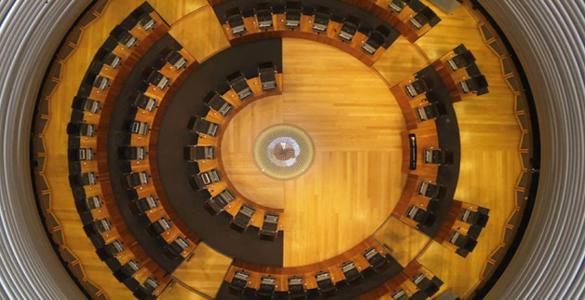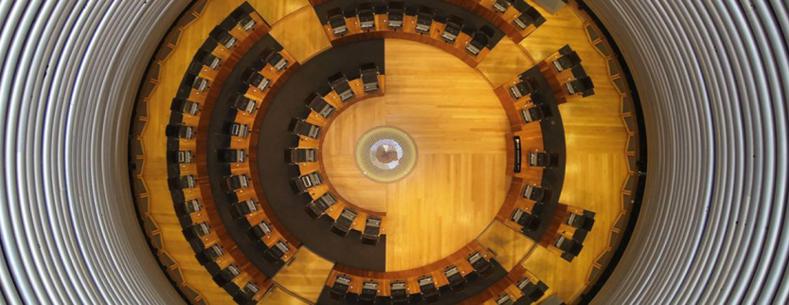Since 2004, a series of reports have recommended that the size of the Senedd should increase from its current 60 Members. Our article on the story of Senedd Reform so far sets out some of this history.
The Special Purpose Committee on Senedd Reform was set up in October 2021 to come up with proposals to be included in a Welsh Government Bill to reform the Senedd. The Senedd will debate the Committee’s findings on 8 June.
Many of the Committee’s proposals are different to those reached in previous reports. Some of the key recommendations are agreed by a majority on the Committee but not all Members.
On 10 May the First Minister, Mark Drakeford and Leader of Plaid Cymru, Adam Price, published a joint statement on Senedd Reform. The proposals agreed by a majority of the Special Purpose Committee are in line with those announced in the statement. The Committee says the statement informed their discussions but decisions on proposals were theirs ‘to take’.
The Welsh Conservative representative on the Committee resigned before the Committee’s report was agreed as a result of the statement .
The Committee calls for reform proposals to be implemented in time for the next election in 2026. Any Bill introduced on Senedd Reform will need a supermajority (40 of the Senedd’s 60 Members) to vote for it for it to pass. If this happens, this could be the last Senedd of 60 Members.
A guide to technical terms included in the report can be found in our glossary.
Size of the Senedd
The Committee report recommends that the size of the Senedd should increase to 96 Members. This is more than the number advocated by the Committee on Senedd Electoral Reform (CSER) and Expert Panel who both agreed the Senedd should be increased to 80-90 Members, with the latter arguing it should be closer to 90.
The Expert Panel also considered the merits of increasing the size beyond 90, but concluded it wasn’t “persuaded that the benefits for enhanced scrutiny of an Assembly of more than 90 Members would necessarily outweigh the resultant increase in costs.”
The Committee’s report argues that an increase beyond 90 is essential to ‘future-proof’ the Senedd. It says major changes in the political landscape since the Expert Panel reported in 2017 - such as Brexit and Covid-19 - mean more Members are now needed.
The proposed number of 96 Members fits with other recommendations made by the Committee about the proposed electoral system, boundary changes and constituency make-up of the Senedd.
The Committee says the size of the Senedd should be specified in primary legislation. This approach would be consistent with that taken in the UK Parliament, the Scottish Parliament and the Northern Ireland Assembly.
Electoral system
The Report recommends that a closed list proportional representation system be used to elect the 96 Members. It recommends that the D’Hondt method be used to apportion seats between parties.
A majority on the Committee recommend that a closed list system should be used to elect Members to the Senedd. Under this system, people vote for a political party, rather than individual candidates. Candidates are elected based on their position on a list, the order of which is determined by political parties.
The majority on the Committee argue this system would create strong and cohesive political parties and ties in with the Committee’s proposals for gender quotas. They also say it will be familiar to voters as it’s the system currently used to elect regional Members in Senedd elections.
A minority on the Committee raised concerns about adopting a closed list system, arguing it would reduce voter choice and “concentrate power” in the hands of political parties.
The Expert Panel identified ten principles against which to evaluate different electoral systems including proportionality, voter choice and member accountability. It rejected closed list proportional representation on the basis it wasn’t “confident [it] could adequately deliver against [its] principles”.
The majority on the Committee recommended the D’Hondt method of translating votes into seats. A minority of the Committee backed the Sainte-Laguë formula, which the Expert Panel noted is “generally accepted to produce more proportional outcomes than D’Hondt.”
The Expert Panel recommended Single Transferable Vote (STV) as its preferred choice. It argued that STV “delivers [on the] principles of proportionality, equivalent status for Members and voter choice”. CSER also recommended that Members should be elected via STV.
A minority on the Committee argued in favour of STV. However, a majority argued that an STV-style ranking system would be unfamiliar to voters in Wales. It also raised concerns about the way votes are transferred into seats in an STV system, arguing that this could be difficult to explain to voters.
Boundaries and constituencies
More Members and a new electoral system would require new Senedd constituencies. The Committee makes proposals for the 2026 election and for the longer term.
For the 2026 election a majority of the Committee proposed 16 constituencies for Senedd elections, each electing six members.
It says these 16 constituencies should be created by pairing together the 32 new UK Parliament constituencies that will be in place by 2023. One Member didn’t agree and believed boundaries should be based on local authority boundaries.
A majority of Committee Members said a streamlined boundary review should be held to pair constituencies for the 2026 elections.
Although a majority of the Committee believes UK Parliament constituencies should be used as a basis for the 2026 elections they don’t believe the two should be linked longer term. They propose that the Local Democracy and Boundary Commission for Wales (which already has powers to review Welsh local authority election boundaries) should also be responsible for reviewing Senedd election boundaries. They say it should be renamed and its governance and resourcing be altered in line with these new responsibilities.
They say a full boundary review should happen before the 2031 Senedd election and a Senedd Reform Bill should set out what should be considered in future reviews as well as timescales for them.
While the Committee says the boundaries of Senedd constituencies should be periodically reviewed, a majority agree the number of constituencies (16) and the number of Members elected in each (six) should not be changed. They call for a Senedd Reform Bill to set this out on its face.
The Committee believes that it’s important each constituency is represented by the same number of Members and includes a broadly equal number of electors. The Committee says six members strikes a balance between allowing greater diversity in the parties elected and avoiding the risk of ‘hyperproportionality’ when parties with only very low levels of public support win seats.
Encouraging a more diverse Senedd
The Committee makes a number of recommendations aimed at encouraging election of a more diverse Senedd, including gender quotas, collecting candidate diversity data and job sharing.
The Committee recommends the Senedd should be elected with integrated statutory gender quotas. This view was also shared by the Expert Panel. The Committee report says it “noted a range of advice” on whether introducing gender quotas is within the Senedd’s legislative competence. It acknowledges that it isn’t possible to come to a view on competence without considering a detailed legislative proposal.
The Committee says the Welsh Government should make sure in drafting the Senedd Reform Bill that it isn’t at undue risk of being referred to the Supreme Court because of questions over whether some of its provisions are within the Senedd’s powers. It recognises that a referral “would almost certainly mean” Senedd reforms couldn’t be in place for the 2026 election.
The Committee notes that time constraints meant it had limited opportunity to consider the implications of legislative quotas for protected characteristics other than gender, and that further work was needed in this area.
The Expert Panel said publishing the diversity information of candidates for Senedd elections could help inform measures to encourage election of a more diverse Senedd. There is currently no requirement to collect or publish this information, although political parties can do so voluntarily.
While the power to require political parties to publish this information is already on the statute book (under section 106 of the Equality Act 2010), this provision has never been commenced.
On the basis that the UK Government is unlikely to commence section 106 in the foreseeable future, the Committee recommends that a Senedd Reform Bill should include an equivalent provision imposing duties on a devolved Welsh authority, such as Returning Officers, to collect and publish candidate diversity information for Senedd elections.
Both the Expert Panel and CSER supported the principle of job sharing for Members to remove barriers which might prevent some from standing for election and encourage election of a more diverse Senedd.
The Committee also believes that job sharing “could enable a greater diversity of candidates to stand for election”, but says it didn’t have time to fully consider the range of practical issues needing to be resolved before an effective job-sharing system could be put in place.
It therefore recommends further consideration should be given to job-sharing on a cross-party basis.
What happens next?
The Welsh Government is expected to bring forward a Senedd Reform Bill to implement the Committee’s recommendations by July-September 2023. The Committee has also said further work is needed in some areas by both the Senedd and Welsh Government before a Senedd Reform Bill is introduced.
The Committee’s findings will be debated in the Senedd on 8 June. You can watch it live on Senedd TV.
Article by Rhun Davies, Philip Lewis & Nia Moss Senedd Research, Welsh Parliament






